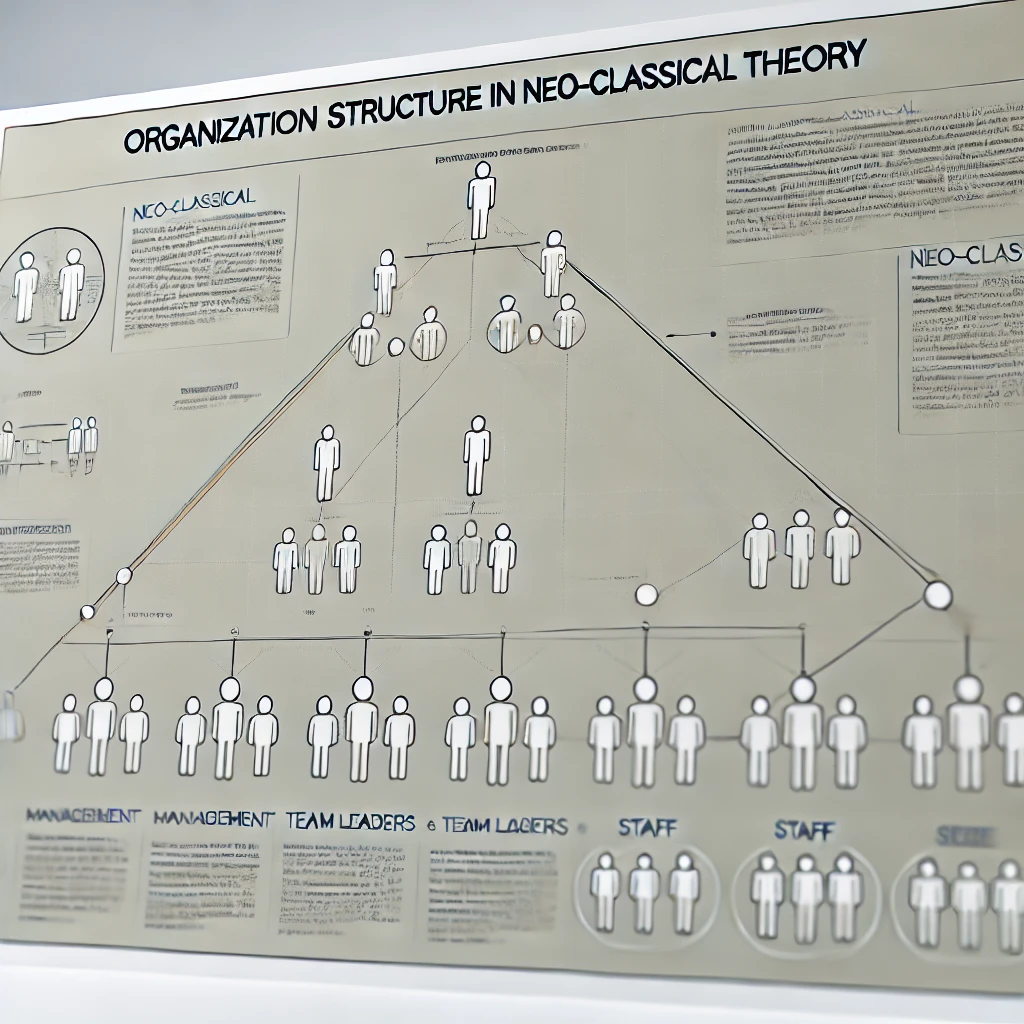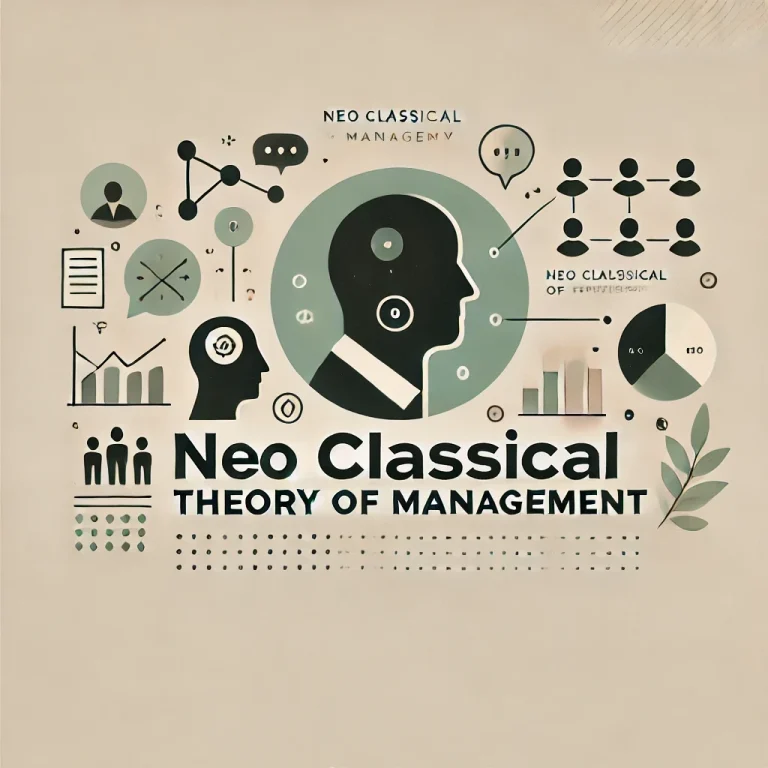Neo-Classical Theory of Management is also a very significant concept as this theory emerged in reaction to the managerial classical theories. In this sense, this theory bases its impetus on work and humanity, founded by the classical management approaches but even emphasizes the human aspect of work. It recognizes the fact that an employee is motivated, not just by the increases in monetary gains but also by social and psychological needs, too. Neo-classical theory explains individual and group relationships at the workplace, communication, and the role of managers in designing a cooperative and harmonious workplace.
What is Neo-Classical Theory?
The Neo-Classical Theory holds importance because it signifies a way out from the rigid straitjackets of classical management theories. Unlike the nineteenth-century classical management theories in the form of Scientific Management and Administrative Management, which were founded largely for efficiency, productivity, and the formal structure of an organization, neo-classical theory recognizes the social aspects of work. It upholds that employees have different needs, motivations, and attitudes, which directly influence productivity and job satisfaction at work.
- Focus on the human relations factor and the behavior of workers.
- Focus on an informal structure of organization affecting groups.
- Importance of communication, motivational levels, and leadership styles for efficient management of workmen.
The Inception of Neo-Classical Theory
Neo-classical theory was developed in the early 20th century as a response to weaknesses and criticism of the classical management theories. The perception of organizations had often been criticized, as it was very mechanical and paid no heed to the human factor that operates within the workplace. Neo-classical theory initiated studies in behavior that characterize management. It incorporated concepts that pointed towards human interaction as important in an organizational context.
Historical Context:
- Originated during the 1920s to 1950s.
- Major influence from the Hawthorne Studies conducted by Elton Mayo and his colleagues.
- Marked a transition from rigid structures to flexible approaches in managing employees.
Features of Neo-Classical Theory
The neo-classical theory of management has several distinguishing features that set it apart from the antecedents in the classical period. These distinguish and specify the emphasis on people-orientated management techniques, whose aim is to boost productivity through the improvement of human behavior within the organization.
- Human Relations Approach: It emphasizes the provision of social contact and relationships between employees. It has indicated that group dynamics play a very important role in deciding the level of productivity.
- Individual Differences: It recognizes the fact that every employee is different in his or her needs and also with distinct motivating factors. It believes that these differences must be grasped well to manage them effectively.
- Informal Organization: It reflects the influence of spontaneously formed informal groups among members. More often than not, they determine the behavior, attitude, and working of employees.
Leadership and Communication: It refers to the salience of communication channels between the management and employees. Instead of authoritative leadership, it stresses the presence of participative leadership.
Organization Structure in Neo-Classical Theory
In the neo-classical approach, the organizational structure is far more flexible in comparison to the rigid frameworks of classical theories. Neo-classical theory advocates a more democratic and participative structure wherein all or at least most of the decision-making processes involve employees with encouragement for airing opinions and feedback.
Key Elements
- Decentralization: Power and decision making are distributed among different levels of the organization.
- Employee Involvement: Involve employees in discussion, whereby they may provide inputs, and in the processes of decision making.
- Fluid Leadership: They consider acting as facilitators rather than dictators to ensure an environment of trust and cooperation.

Advantages of Neo-Classical Organizational Structure:
- Better Adaptability: More sensitive to the environment as well as market needs.
- Improved Satisfaction of Employees: Employees will feel valued, hence more morale and motivation.
- Open Communication: Generates open communication, reduces misunderstandings and possible conflict with others.
The Criticism of Neo-Classical Theory
The neo-classical theory has had much focus on informal organization and human behavior but, in doing so, has come in for a lot of criticism because it has limitations and drawbacks. Critics argue that this approach, though progressive at times, lacks a scientific basis sometimes, failing to accommodate what is considered as the intricacies of more modern and complex organizational dynamics.
Overemphasis on Human Relations: Social and psychological needs give critical importance that resultantly overshadows the basics of productivity and efficiency. Financial incentives get downplayed as a motivator.
Less Structured Framework: Compared to the classical theories, neo-classical theory doesn’t provide any strong or consistent structure for organizational management. It is based more upon empirical observations than systematic principles.
Neglect of technological and environmental factors: Fails to have in mind the changes in technology that form a prominent influence on the behaviors of organizations along with external environmental factors. In the context of modern business environments, human elements must be balanced against the integration of modern technologies.
Conclusion
Neo Classical Theory of Management is an important development in understanding how human behavior fits into organizational efficiency. This theory comes forward to rectify shortcomings of the classical theories keeping into consideration social relations, communication, and participative leadership. Still, the neoclassical theory sets up the modulation for the modern management approaches, as these concentrate on the psychological and social aspects of work.
Neo Classical Theory of Management FAQs
What is the main focus of neo-classical theory?
The primary focus of neo-classical theory is on human relations and the importance of social and psychological factors in improving employee productivity and satisfaction.
What is the difference between classical and neo-classical theory of management?
While classical theory emphasizes organizational structure, efficiency, and financial incentives, neo-classical theory focuses on human behavior, social interactions, and employee well-being.
How did the Hawthorne Studies influence the neo-classical theory?
The Hawthorne Studies highlighted the impact of social factors on productivity, leading to the realization that employee morale and group dynamics play a significant role in workplace efficiency.
What are the limitations of neo-classical theory?
Neo classical theory has been criticized for overemphasizing human relations, lacking a structured framework, and failing to consider technological and environmental influences on organizational behavior.
How does the neo-classical approach affect leadership styles in an organization?
The neo-classical approach encourages participative leadership styles, where leaders act as facilitators and encourage open communication and employee involvement in decision-making.


